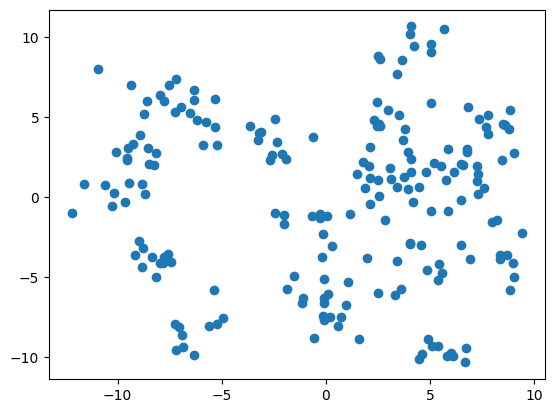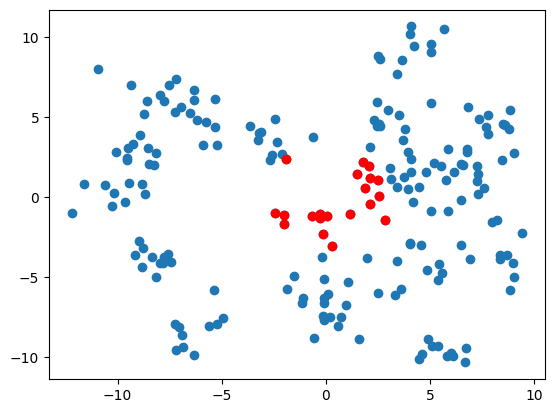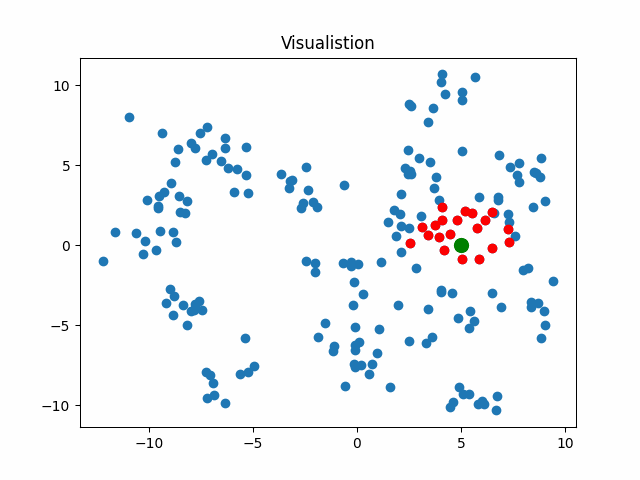Nearest neighbors#
Is algorithm that allows to build find closest points
import io
from IPython.display import Image as IPImage
import numpy as np
import pandas as pd
import matplotlib.pyplot as plt
from sklearn.neighbors import NearestNeighbors
from sklearn.datasets import make_blobs
Example#
Let’s consider an example - a set of two-dimensional objects that we are going to use among which we need to choose some set of the closest to the given object.
X, _ = make_blobs(
n_samples=200,
random_state=10,
centers=20
)
plt.scatter(X[:,0], X[:,1])
plt.show()

To use sklearn.neighbours.NearestNeighbours we need to define the number of neighbours and apply it to the data under consideration.
nn = NearestNeighbors(n_neighbors=20).fit(X)
kneighbors method#
To get predictions, we need to use the kneighbors method on this object. The following example shows oupt for two specified points.
distances, indices = nn.kneighbors([[0,0], [2,2]])
display(pd.concat(
{
"distances" : pd.DataFrame(distances.T),
"idices" : pd.DataFrame(indices.T)
},
axis = 1
))
| distances | idices | |||
|---|---|---|---|---|
| 0 | 1 | 0 | 1 | |
| 0 | 1.091216 | 0.074815 | 170 | 40 |
| 1 | 1.138347 | 0.302468 | 118 | 142 |
| 2 | 1.309527 | 0.724875 | 45 | 10 |
| 3 | 1.336416 | 0.770803 | 54 | 62 |
| 4 | 1.535604 | 1.045741 | 71 | 84 |
| 5 | 1.980926 | 1.082107 | 137 | 122 |
| 6 | 2.103606 | 1.185385 | 10 | 18 |
| 7 | 2.159102 | 1.392603 | 151 | 137 |
| 8 | 2.286014 | 1.403301 | 70 | 51 |
| 9 | 2.294783 | 1.901535 | 76 | 144 |
| 10 | 2.452250 | 1.964599 | 62 | 50 |
| 11 | 2.565371 | 1.995106 | 50 | 149 |
| 12 | 2.629244 | 2.133964 | 29 | 47 |
| 13 | 2.630536 | 2.136047 | 46 | 75 |
| 14 | 2.745844 | 2.145365 | 84 | 11 |
| 15 | 2.853642 | 2.319772 | 40 | 127 |
| 16 | 2.868993 | 2.435027 | 142 | 151 |
| 17 | 3.049752 | 2.472242 | 80 | 128 |
| 18 | 3.080130 | 2.513303 | 160 | 113 |
| 19 | 3.164793 | 2.517343 | 166 | 61 |
For each object it returns the distances to the neighbours and the indices of the neighbours.
kneighbors_graph method#
kneighbors_graph is an alternative way of extracting neighbours. It returns neighbor elements as boolean mapping 1 - means that object corresponds to the set of neighbor objects, 0 doesn’t.
graph = nn.kneighbors_graph([[0,0]]).toarray()[0]
display(graph)
plt.scatter(
X[:,0], X[:,1]
)
plt.scatter(
X[graph.astype("bool"),0],
X[graph.astype("bool"),1],
color="red"
)
plt.show()
array([0., 0., 0., 0., 0., 0., 0., 0., 0., 0., 1., 0., 0., 0., 0., 0., 0.,
0., 0., 0., 0., 0., 0., 0., 0., 0., 0., 0., 0., 1., 0., 0., 0., 0.,
0., 0., 0., 0., 0., 0., 1., 0., 0., 0., 0., 1., 1., 0., 0., 0., 1.,
0., 0., 0., 1., 0., 0., 0., 0., 0., 0., 0., 1., 0., 0., 0., 0., 0.,
0., 0., 1., 1., 0., 0., 0., 0., 1., 0., 0., 0., 1., 0., 0., 0., 1.,
0., 0., 0., 0., 0., 0., 0., 0., 0., 0., 0., 0., 0., 0., 0., 0., 0.,
0., 0., 0., 0., 0., 0., 0., 0., 0., 0., 0., 0., 0., 0., 0., 0., 1.,
0., 0., 0., 0., 0., 0., 0., 0., 0., 0., 0., 0., 0., 0., 0., 0., 0.,
0., 1., 0., 0., 0., 0., 1., 0., 0., 0., 0., 0., 0., 0., 0., 1., 0.,
0., 0., 0., 0., 0., 0., 0., 1., 0., 0., 0., 0., 0., 1., 0., 0., 0.,
1., 0., 0., 0., 0., 0., 0., 0., 0., 0., 0., 0., 0., 0., 0., 0., 0.,
0., 0., 0., 0., 0., 0., 0., 0., 0., 0., 0., 0., 0.])

Visualisation#
The next cell represents a set of functions that allows to visualise the results of the nearest neighbours algorithm. It’s often used in notebooks in this section, so it’s stored in a separate module.
%%writefile nearest_neighbors_files/visualisations.py
import io
import PIL
from PIL import Image
import numpy as np
from sklearn.neighbors import NearestNeighbors
import matplotlib.pyplot as plt
def get_picture(
coordinates : list[float],
nn : NearestNeighbors,
X : np.array,
title : str
) -> PIL.PngImagePlugin.PngImageFile:
'''
Get picture that show neighbours
for given coordinates.
Parameters
----------
coordinates : list[float]
сoordinates for which you need
to find neighbours;
nn : sklearn.neighbors.NearestNeighbors
algorithm under consideration;
X : np.array of shape (n_samples, 2)
this is two dimentional objects
that will be represented at the
scatter plot;
title : str
title that will be used for plot.
Returns
-------
out : PIL.PngImagePlugin.PngImageFile
picture with scatters.
'''
# getting neighrours
distances, indices = nn.kneighbors([coordinates])
# plotting scatter
fig, ax = plt.subplots()
ax.scatter(
coordinates[0],
coordinates[1],
color="Green",
s=100
)
ax.scatter(X[:,0], X[:,1])
ax.scatter(X[indices, 0], X[indices, 1], color="red")
plt.title(title)
# saving to buffer
buf = io.BytesIO()
plt.savefig(buf, format='png')
buf.seek(0)
plt.close(fig)
return Image.open(buf)
def get_gif(
coordinates : list[list[float]],
nn : NearestNeighbors,
X : np.array,
pictures_args : dict = {}
)->io.BytesIO:
'''
Get buffer containing gif
file with animation where point
for which neighbours, moving
according to given array.
Parameters
----------
coordinates : list[list[float]]
array of coordinate combinations
along which the point will move
and for which we need to find neighbours;
nn : sklearn.neighbors.NearestNeighbors
algorithm under consideration;
X : np.array of shape (n_samples, 2)
this is two dimentional objects
that will be represented at the
scatter plot;
pictures_args : dict
this funciton is wrapper under get_picture
so you can specify arguemnst to it.
'''
# generate frames on which the
# coordinate to which neighbours
# are searched moves in a circle.
frames = [
get_picture(
coordinates=cord,
nn=nn,
X=X,
**pictures_args
)
for cord in coordinates
]
# creating buffer with gif file
# and displaying it
gif_buf = io.BytesIO()
frames[0].save(
gif_buf,
format='GIF',
save_all=True,
append_images=frames[1:],
duration=100,
loop=0
)
gif_buf.seek(0)
return gif_buf
def get_circle_gif(
nn : NearestNeighbors,
X : np.array,
radius : float = 5,
frames : int = 100,
center : list = [0,0],
pictures_args : dict = {}
)->io.BytesIO:
'''
Visualises the nearest neighbours to a
point that walks in a circle.
Parameters
----------
nn : sklearn.neighbors.NearestNeighbors
algorithm under consideration;
X : np.array of shape (n_samples, 2)
this is two dimentional objects
that will be represented at the
scatter plot;
radius : float, default=5
radius of the circle;
frames : int, deafult=5
number of frames that will
be used to build the gif;
center : list[float] of len 2, default=[0,0]
center of the circle;
pictures_args : dict
this funciton is wrapper under get_picture
so you can specify arguemnst to it.
'''
return get_gif(
coordinates=[
[
center[0] + np.cos(angle)*radius,
center[1] + np.sin(angle)*radius
]
for angle in np.linspace(0, 2*np.pi, frames)
],
nn=nn, X=X,
pictures_args=pictures_args,
)
Overwriting nearest_neighbors_files/visualisations.py
Here is an animation showing the result of the algorithm for different positions of the considered point (green point). The closest neighbours at any time are shown as red dots.
import nearest_neighbors_files.visualisations as visualisations
gif_buf = visualisations.get_circle_gif(
nn, X,
pictures_args=dict(
title="Visualistion"
)
)
IPImage(data=gif_buf.getvalue())

